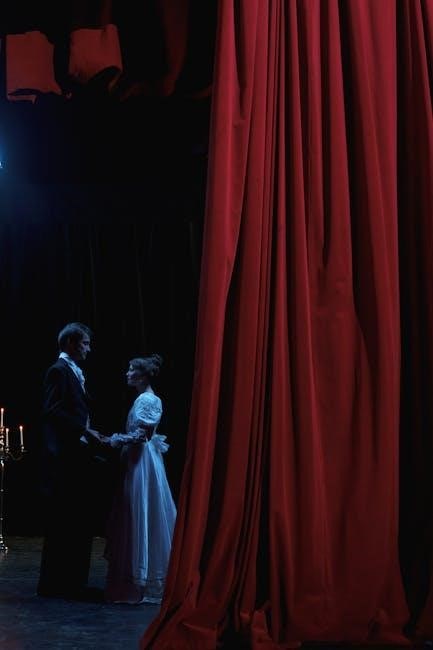A high-spirited Victorian-era musical comedy, A Gentleman’s Guide to Love and Murder tells the darkly humorous tale of Monty Navarro, a man who rises through a family line by eliminating heirs, blending charm, murder, and wit. Featuring a standout performance by an actor playing multiple roles, this Tony Award-winning play combines catchy music with a clever plot, offering a unique theatrical experience.
1.1 Background and Premise
A Gentleman’s Guide to Love and Murder is a musical comedy based on Roy Horniman’s 1907 novel, Israel Rank: The Autobiography of a Criminal. The story follows Monty Navarro, a penniless clerk who discovers he is ninth in line to the Earldom of Highhurst. Driven by ambition and revenge, Monty devises a darkly comedic plan to eliminate the eight heirs ahead of him. Set in 1907 London, the play blends murder, romance, and wit, offering a satirical take on social class and inheritance. Its unique premise, featuring one actor playing all doomed heirs, has made it a standout in musical theatre.
1.2 Genre and Tone
A Gentleman’s Guide to Love and Murder is a musical comedy with a satirical edge, blending dark humor, wit, and murder. Its tone is both sophisticated and irreverent, reflecting the Victorian era’s social norms while poking fun at them. The play’s genre combines elements of farce, romance, and crime, creating a unique theatrical experience. The music, by Steven Lutvak, is catchy and clever, enhancing the story’s darkly comedic tone. This mix of genres and tones makes the play a standout in musical theatre, appealing to audiences with its balance of humor and intrigue.
1.3 Historical Context
A Gentleman’s Guide to Love and Murder is set in London in 1907, reflecting the social stratification and moral hypocrisy of the early 20th century. Based on Roy Horniman’s 1907 novel Israel Rank: The Autobiography of a Criminal, the play satirizes the rigid class system and inheritance laws of the time. Its historical context is enriched by the Victorian era’s etiquette and the rise of the middle class, providing a backdrop for Monty Navarro’s climb up the social ladder. The play’s themes of ambition and revenge are timeless yet deeply rooted in the era’s societal norms.

The Story and Plot
A Gentleman’s Guide to Love and Murder follows Monty Navarro, a penniless clerk, as he discovers he’s ninth in line to an earldom and devises a darkly comedic strategy to eliminate the heirs standing in his way, blending revenge, romance, and witty humor.
2.1 Setting: London in 1907
The story unfolds in London during 1907, a time of strict social hierarchy and Victorian-era propriety. The setting reflects the opulence of the wealthy D’Ysquith family, contrasting with Monty’s humble beginnings. The city’s vibrant yet rigid society provides a backdrop for themes of class and ambition. Visual elements like elaborate costumes and detailed set designs evoke the era’s grandeur, while the narrative’s dark humor and murder plot add a subversive twist to the period’s decorum. This setting immerses the audience in a world of etiquette and intrigue, where Monty’s rise through murder is both shocking and absurdly entertaining.
2.2 The Prologue: A Warning to the Audience
The play opens with a prologue featuring a chorus of mourners, who ominously warn the audience about the disturbing nature of the story to come. They suggest that those with weaker constitutions leave immediately, setting a darkly humorous tone. This opening scene serves as a clever device to prepare viewers for the murderous plot and its lighthearted yet macabre execution. By addressing the audience directly, the prologue creates a sense of complicity, drawing viewers into the morally ambiguous world of Monty Navarro’s tale of revenge and ambition.
2.3 The Prison Cell and Monty’s Memoir
The story begins in a dimly lit prison cell in 1909, where Lord Montague D’Ysquith Navarro, the Ninth Earl of Highhurst, is writing his memoir, A Gentleman’s Guide to Love and Murder. This framing device sets the tone for the narrative, as Monty reflects on his journey from a penniless clerk to an earl. The memoir serves as both a confession and a justification for his actions, blending dark humor with a recounting of his murderous ascent. This opening scene transitions seamlessly into the flashback, immersing the audience in the tale of revenge, ambition, and societal satire.
2.4 The Line of Succession and Monty’s Ambition
Monty Navarro, a penniless clerk, discovers he is ninth in line to the D’Ysquith earldom. Driven by ambition and a desire for wealth, he devises a plan to eliminate the eight heirs ahead of him. His journey is marked by charm, wit, and calculated ruthlessness, as he navigates the complexities of the family line. The succession plot serves as the backbone of the story, showcasing Monty’s transformation from an outsider to a man of privilege. This ambitious pursuit not only fuels the narrative but also highlights the societal commentary on class and inheritance, central to the play’s dark humor and satire.

Characters and Casting
The play features Monty Navarro, a charming protagonist, and the eccentric D’Ysquith family. One actor masterfully portrays all eight doomed heirs, showcasing comedic brilliance and versatility.

3.1 Monty Navarro: The Protagonist
Monty Navarro, the ninth Earl of Highhurst, is a penniless clerk who discovers his place in the D’Ysquith family line. Driven by ambition and revenge, he cleverly eliminates heirs to inherit the earldom. His charm and wit make him a compelling yet morally ambiguous character. Monty’s journey from rags to riches is both darkly humorous and intriguing, as he navigates love, murder, and societal expectations. His dual nature—charming yet ruthless—captivates audiences, making him a standout protagonist in this musical comedy.
3.2 The D’Ysquith Family and Their Heirs
The D’Ysquith family represents the epitome of aristocratic power and wealth, controlling the earldom of Highhurst. Monty Navarro, a distant relative, discovers he is ninth in line to inherit. The family’s heirs are portrayed as eccentric and self-absorbed, each meeting a creatively humorous demise. One actor masterfully plays all eight doomed heirs, showcasing comedic brilliance and versatility. Their deaths, orchestrated by Monty, drive the plot’s dark humor and highlight his cunning ambition. The D’Ysquiths’ downfall is both tragic and absurd, reflecting the play’s satirical take on class and inheritance.
3.3 The Actor Playing Multiple Roles
The actor portraying the D’Ysquith heirs is a standout element of the play, showcasing incredible versatility. One performer masterfully embodies eight distinct characters, each with unique personalities and quirks. This demanding role requires rapid costume changes, vocal adjustments, and precise comedic timing. The actor’s ability to seamlessly transition between characters is a testament to their skill and adds to the play’s humor and pacing. This unique aspect delights audiences and highlights the production’s creative brilliance, making it a defining feature of the musical’s success and a key element in its critical acclaim.

3.4 Supporting Characters: Love Interests and Allies

The play features a cast of vibrant supporting characters who shape Monty’s journey. Phoebe D’Ysquith, a kind-hearted cousin, and Sibella Hallward, a charming but self-serving lover, represent Monty’s conflicting romantic interests. These women embody contrasting ideals of love and ambition, influencing his decisions. Additionally, characters like Miss Shingle and Detective Pinckney add depth, providing comedic relief and tension. Each supporting role enhances the narrative, offering layers of humor, drama, and complexity to Monty’s quest for inheritance and love, making the story engaging and multifaceted.
Themes and Messages
The play masterfully blends dark humor with a critique of social class, exploring ambition’s moral complexities through Monty’s rise, all while maintaining a gentlemanly facade.
4.1 Revenge and Ambition
At the heart of A Gentleman’s Guide to Love and Murder lies Monty Navarro’s relentless pursuit of revenge and ambition. Driven by his desire to reclaim the D’Ysquith family fortune, Monty systematically eliminates the heirs standing in his way. His journey is a darkly comedic exploration of morality, where charm and wit mask ruthless calculation. The play delves into the blurred lines between justice and vengeance, questioning the true cost of ambition. Through Monty’s rise, the musical highlights the dangers of unchecked desire and the enduring appeal of a well-crafted revenge story, leaving audiences both entertained and reflective.
4.2 Social Class and Inheritance
A Gentleman’s Guide to Love and Murder satirically explores the rigid social hierarchy of 1907 London, where inheritance and titles define worth. Monty Navarro, a penniless clerk, navigates the aristocratic D’Ysquith family’s complexities, exposing the absurdity of class privilege. The play critiques the societal obsession with lineage, as Monty’s ambition challenges the notion that birthright determines value. Through its dark humor, the musical highlights the tension between merit and inheritance, offering a sharp commentary on the class system’s flaws and the moral compromises it fosters.
4.3 Love and Relationships
A Gentleman’s Guide to Love and Murder intricately weaves love and relationships into its darkly comedic narrative. Monty Navarro’s romantic interests, Phoebe D’Ysquith and Sibella Hallward, represent opposing ideals: innocence and passion. His pursuit of both women highlights the complexity of love amidst ambition. The play portrays love as a casualty of Monty’s ruthless climb, showcasing how relationships are manipulated for personal gain. Through these dynamics, the musical explores the tension between genuine affection and self-serving desires, adding depth to its exploration of human morality and societal expectations. Love becomes a pawn in Monty’s game of survival and legacy.
4.4 Morality and Justice
A Gentleman’s Guide to Love and Murder explores morality and justice through Monty Navarro’s morally ambiguous journey. The play presents murder as a darkly comedic means to an end, challenging traditional notions of right and wrong. Monty’s actions blur the line between justice and vengeance, raising questions about the ethics of his choices. The musical’s tone suggests that justice is relative, often favoring those who seize power. This moral ambiguity leaves the audience questioning whether Monty’s crimes are justified or condemned, adding depth to the play’s exploration of human nature and societal norms.

Music and Lyrics
The musical features witty, sophisticated compositions by Steven Lutvak and Robert L. Freedman, blending dark humor with charm. The songs cleverly complement the storyline, enhancing character development and plot twists with their Victorian-era-inspired melodies.
5.1 The Musical Style and Composition
The musical style of A Gentleman’s Guide to Love and Murder is a sophisticated blend of wit and darkness, with compositions by Steven Lutvak and lyrics by Lutvak and Robert L. Freedman. The score, inspired by the Victorian era, features intricate melodies and clever wordplay, perfectly capturing the show’s dark humor and charm. The music seamlessly integrates with the plot, enhancing character development and advancing the story. Its unique style, combining operetta-like grandeur with modern musical theater sensibilities, creates a distinctive and engaging auditory experience that complements the play’s murderous yet comedic tone.
5.2 Notable Songs and Their Significance
The musical features several standout songs that drive the plot and reveal character depth. The opening number, A Warning to the Audience, sets a darkly comedic tone, while I Don’t Understand the World highlights Monty’s frustration and ambition. Foolish to Think showcases his romantic and murderous intentions, blending humor with menace. Poison in My Pocket underscores his cunning, and I’ve Decided to Marry You provides a hilarious trio of love interests. Each song advances the story, deepening the audience’s connection to Monty’s morally ambiguous journey, while maintaining the play’s lighthearted yet murderous charm.
5.3 The Role of Music in Advancing the Plot
The music in A Gentleman’s Guide to Love and Murder is intricately woven into the narrative, driving the plot forward with wit and precision. Each song reveals character motivations and escalates tension, blending humor with darkness. The opening number, A Warning to the Audience, sets the tone, while I Don’t Understand the World highlights Monty’s growing frustration. The score transitions seamlessly between lighthearted moments and murderous schemes, maintaining the play’s comedic yet sinister edge. Music not only enhances emotional depth but also accelerates Monty’s descent into morality, making it a vital storytelling tool.
5.4 Orchestration and Instrumental Choices
The orchestration in A Gentleman’s Guide to Love and Murder features a small ensemble, creating an intimate yet dynamic sound. Brass instruments, particularly the trumpet, are prominently used to evoke a sense of grandeur and humor. The plunger mute technique adds a unique, almost vocal quality, enhancing comedic moments. Strings provide emotional depth, while percussion underscores the play’s darkly comedic tone. The instrumentation is carefully chosen to reflect the Victorian era’s elegance, blending seamlessly with the story’s wit and murder, ensuring the music complements both the plot and character development effectively.

Stagecraft and Design
The play’s stagecraft masterfully blends visual and auditory elements, creating a Victorian-era aesthetic. Clever set changes, lighting, and sound design enhance the dark humor and dynamic storytelling, immersing the audience in Monty’s murderous escapades.
6.1 Set Design and Visual Elements
The set design for A Gentleman’s Guide to Love and Murder is a masterclass in versatility, with sliding panels and rotating pieces that seamlessly transition between scenes. The visual elements evoke a Victorian-era aesthetic, featuring intricate details like gilded frames, ornate furniture, and period-specific props. These design choices not only enhance the storytelling but also reflect Monty’s journey from a humble clerk to a high-society earl. The clever use of space and visual motifs ensures the audience is immersed in the world of 1907 London, blending humor and murder with a touch of elegance.
6.2 Costume Design and Character Representation
The costume design in A Gentleman’s Guide to Love and Murder is a vibrant reflection of the Victorian era, with intricate details that highlight social class and character traits. Monty Navarro’s transformation from a penniless clerk to an earl is mirrored in his evolving wardrobe, transitioning from modest attire to tailored suits. The D’Ysquith family members are dressed in opulent, exaggerated costumes that emphasize their aristocratic status. Color palettes and accessories, such as hats and gloves, further distinguish each character, while the actor playing multiple roles relies on quick costume changes and distinct styling to bring each heir to life.
6.3 Lighting and Special Effects

Lighting and special effects in A Gentleman’s Guide to Love and Murder play a crucial role in setting the tone and enhancing the storytelling. Dramatic lighting highlights key moments, such as the eerie prologue and the prison cell scenes, creating a sense of suspense. Special effects, including fog and shadow play, are used to emphasize the dark humor and murder scenes. The lighting design also helps guide the audience’s focus, ensuring smooth transitions between settings like London streets and aristocratic estates. These elements seamlessly blend with the play’s Victorian aesthetic, heightening the overall theatrical experience.
6.4 The Challenge of Playing Multiple Roles
In A Gentleman’s Guide to Love and Murder, the actor portraying the D’Ysquith family heirs faces the daunting task of playing eight distinct characters. Quick costume changes, varying accents, and exaggerated mannerisms are essential to differentiate each role. The physical and mental demands are immense, requiring precise timing and seamless transitions. This theatrical feat showcases the actor’s versatility and skill, as they must maintain unique identities for each character while keeping the audience engaged. The challenge lies in making each heir memorable and distinct, ensuring the comedy and drama resonate effectively throughout the performance.
Reception and Reviews
A Gentleman’s Guide to Love and Murder received critical acclaim for its witty humor, clever plot, and standout performances, earning it the title of “knock-em-dead hit” and “audience favorite.”
7.1 Critical Acclaim and Praise
A Gentleman’s Guide to Love and Murder garnered widespread critical acclaim for its ingenious blend of dark humor, witty dialogue, and exceptional performances. The musical was hailed as a “knock-em-dead hit” and praised for its originality and clever storytelling. Jefferson Mays’ standout portrayal of multiple D’Ysquith heirs earned him a Tony Award, while the show itself won the 2014 Tony Award for Best Musical. Critics lauded the production’s ability to balance murder, mayhem, and melody, making it a standout in musical theatre. Its unique charm and comedic brilliance solidified its place as a modern classic.
7.2 Audience Response and Popularity
Audiences embraced A Gentleman’s Guide to Love and Murder with enthusiasm, drawn to its unique blend of dark humor, catchy music, and clever storytelling. The play’s ability to balance murder, mayhem, and melody resonated widely, making it a crowd favorite. Its Broadway run from November 17, 2013, to January 17, 2016, showcased its enduring appeal. Fans praised the production’s energy, wit, and the standout performance of Jefferson Mays. The musical’s popularity continues, with future productions scheduled, ensuring its charm and humor remain a delight for new and returning audiences alike.
7.3 Comparisons to Other Musicals
A Gentleman’s Guide to Love and Murder is often hailed as a modern masterpiece of musical comedy, drawing comparisons to classics like The Book of Mormon and Monty Python’s Spamalot. Its dark humor, clever wit, and intricate plot have earned it a reputation as a standout in the genre. Critics praise its unique blend of murder, mayhem, and melody, setting it apart from other musicals. The play’s ability to balance lightheartedness with macabre themes makes it a compelling watch, much like its predecessors in the comedy-mystery space.
7.4 Controversies and Criticisms
Despite its acclaim, A Gentleman’s Guide to Love and Murder has faced criticism for its dark humor and macabre themes. Some viewers find the comedic portrayal of murder offensive, while others argue it trivializes violence. The prologue’s warning to the audience has sparked debate, with critics questioning its tone. Additionally, the play’s use of murder as entertainment has been labeled insensitive by a few. However, supporters defend it as a clever satire, emphasizing its theatricality and comedic intent. The production’s bold approach continues to divide opinions, making it a subject of both praise and controversy.

Awards and Recognition
A Gentleman’s Guide to Love and Murder won the 2014 Tony Award for Best Musical, with Jefferson Mays and Bryce Pinkham earning nominations. Robert L. Freedman received the Tony for Best Book, and the play also claimed Drama Desk Awards, solidifying its acclaim in musical theatre history.
8.1 Tony Awards and Nominations
A Gentleman’s Guide to Love and Murder triumphed at the 2014 Tony Awards, winning Best Musical. Jefferson Mays received a nomination for Best Actor in a Musical, while Bryce Pinkham was nominated for Best Featured Actor. Robert L. Freedman won the Tony for Best Book of a Musical, and the play also earned nominations for Best Direction and Best Costume Design. These accolades highlighted the production’s exceptional storytelling, performances, and creative vision, cementing its place as a standout in musical theatre history.
8.2 Drama Desk Awards and Other Honors
A Gentleman’s Guide to Love and Murder earned widespread critical acclaim, winning multiple Drama Desk Awards. It received Outstanding Musical, Outstanding Book for Robert L; Freedman, and Outstanding Music for Steven Lutvak. Jefferson Mays also won Outstanding Actor in a Musical for his remarkable performance. Additionally, the play was honored with the Outer Critics Circle Award for Outstanding New Broadway Musical. These recognitions underscored the production’s creative brilliance and its ability to captivate audiences with its unique blend of humor, music, and drama.
8.3 The Impact of Awards on the Play’s Success
The numerous awards and nominations significantly boosted the play’s popularity and longevity. Winning the Tony Award for Best Musical in 2014 catapulted A Gentleman’s Guide to Love and Murder into the spotlight, attracting new audiences and extending its Broadway run. The Drama Desk Awards and other honors further solidified its reputation as a standout musical. The acclaim not only increased ticket sales but also led to national tours and international productions, ensuring its success beyond New York. The recognition also highlighted the talents of its cast and creative team, cementing its legacy in musical theatre history.
The Play’s Legacy
A Gentleman’s Guide to Love and Murder has left a lasting impact on musical theatre, inspiring future productions with its unique blend of dark humor and catchy music. Its educational value lies in its intricate storytelling and innovative character portrayals, making it a timeless classic. The play’s cultural significance continues to grow, ensuring its appeal to future audiences and solidifying its place as a landmark musical comedy.
9.1 Influence on Musical Theatre
A Gentleman’s Guide to Love and Murder has significantly influenced musical theatre by redefining comedic storytelling. Its dark humor, paired with catchy music, set a new standard for musical comedies. The play’s innovative approach to multi-role acting, where one performer portrays multiple characters, has inspired creative casting in other productions. Its success has encouraged writers to explore unconventional narratives, blending murder mysteries with wit and charm. This Tony Award-winning musical has become a benchmark for blending intricate plots with memorable music, leaving a lasting impact on the genre’s evolution and inspiring future playwrights and composers.
9.2 Educational Value and Adaptations
A Gentleman’s Guide to Love and Murder offers significant educational value, particularly in theater programs, for its unique blend of dark humor, intricate plotting, and multi-role acting. The play’s adaptation from Roy Horniman’s novel demonstrates how literary works can be reimagined for the stage. Its complex characters and moral dilemmas provide rich material for analysis, while the challenge of portraying multiple roles makes it a valuable tool for teaching acting techniques. The musical’s success has also inspired adaptations and interpretations in schools and universities, fostering creativity and understanding of theatrical storytelling.
9.3 Cultural Significance and Timelessness
A Gentleman’s Guide to Love and Murder holds enduring cultural significance as a masterful blend of dark humor, intricate plotting, and multi-role acting. Its timeless appeal lies in its universal themes of ambition, morality, and social class, resonating across generations. The play’s clever adaptation of Roy Horniman’s novel showcases the adaptability of storytelling, while its Tony Award-winning success solidifies its place in musical theatre history. The production’s unique blend of wit, music, and theatrical innovation ensures its relevance, making it a timeless classic that continues to captivate audiences with its enduring charm and intellectual depth.
9.4 Future Productions and Revivals
With its enduring popularity, A Gentleman’s Guide to Love and Murder continues to attract new audiences, ensuring future productions and revivals. The play’s unique blend of dark humor, intricate plot, and multi-role acting makes it a favorite for theatres worldwide. Upcoming productions, such as the June 2025 run, highlight its sustained appeal. The play’s versatility and timeless themes guarantee its place in musical theatre, with plans for regional tours and international stagings. Its Tony Award-winning legacy and cultural impact ensure that this murderous romp will remain a beloved classic, entertaining audiences for years to come.
A Gentleman’s Guide to Love and Murder captivates with its dark humor, clever plot, and unforgettable music, leaving audiences enchanted and eager for more of its timeless charm.
10.1 Final Thoughts on the Play’s Appeal
A Gentleman’s Guide to Love and Murder captivates audiences with its blend of dark humor, witty dialogue, and standout performances. The play’s unique charm lies in its ability to balance murder and mayhem with lightheartedness, creating a hilarious yet intriguing narrative. Monty Navarro’s journey, paired with the actor’s remarkable portrayal of multiple roles, leaves a lasting impression. The catchy music and clever plot twists further enhance the experience, making it a must-watch for fans of musical comedy. Its timeless appeal ensures it remains a beloved choice for theater enthusiasts seeking both entertainment and intellectual engagement.
10.2 The Enduring Charm of “A Gentleman’s Guide to Love and Murder”
The play’s enduring charm stems from its masterful blend of murder, mayhem, and comedy, creating a uniquely entertaining experience. The actor’s challenge of portraying multiple heirs adds a layer of brilliance, captivating audiences with sheer versatility. Its witty dialogue, coupled with a rich musical score, ensures a memorable journey. The timeless themes of ambition and revenge, wrapped in Victorian elegance, resonate universally. This Tony Award-winning musical remains a standout, offering a fresh take on dark humor and theatrical innovation, solidifying its place as a modern classic in musical theatre.
